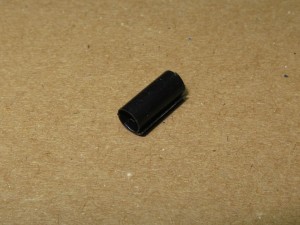 Micromouse sensors need shielding to work at their best. Here we are going to show you how to make a simple, flexible light shield for your micromouse sensors that will cut down the effect of ambient light and reduce leakage from the emitter.
Micromouse sensors need shielding to work at their best. Here we are going to show you how to make a simple, flexible light shield for your micromouse sensors that will cut down the effect of ambient light and reduce leakage from the emitter.
The problem with micromouse sensors
The common reflective micromouse sensors can suffer a lot from ambient light. It is easy to subtract that out from the signal in software but the linearity of the sensor, and its dynamic range, will suffer if high ambient light levels are allowed to reach the sensor.
Ideally, with the sensor pointing into empty space, with no wall or other obstruction, you will see a low reading with the emitter off. That reading should increase as little as possible as the ambient levels get higher. Remember that, with a wall present, you can’t stop the sensor from seeing the illumination of the wall by ambient light.
Another problem is that, when the emitter is turned on, some of that light will be seen by the sensor even without a wall nearby. That leakage can be hard to eliminate and represents a constant value that is added to the apparent response. Again, it is easy enough to take care of in software but it will reduce the range of values that you can get from the sensor.
When the emitter goes on, light can leak in from surprising places.even with quite a lot of shielding, light may bounce off components on the board, or even travel through the PCB. Bear in mind that epoxy PCB material is pretty transparent to Infra Red.
The normal solution is to either put the emitter and sensor into a holder that keeps them from seeing each other or to put heat shrink tubing over the detector, or emitter, or both. This is the easiest way to do it and is very effective. I found that trimming the heat shrink to exactly the shape I want and providing just the right amount of shielding was fiddly and prone to error. If you cut off too much shielding, you have to start again.
Better shielding for your micromouse sensors
Black plastic drinking straws are often quite opaque to IR light and would make great shield except that they are too big.
Clearly, a 3mm detector rattles around in there and cannot be properly mounted. 5mm sensors are just as bad in practice. Try as I might, I couldn’t find any black drinking straws that were just the right size. Then it occurred to me that I could cut the straw along its length and roll it up tighter. Once that is done, the straw keeps its small diameter and will unroll a little to fit snugly over the detector. It works for both 3mm and 5mm detectors.
Now I can put some heat shrink over the top of that to hold it neatly in place an provide shielding for the rear of the device. Do this carefully to avoid melting the drinking straw. After the heat shrink has cooled down, the length of straw can be pulled out. At this point, you already have a nice neat light shield.


There is a gap between the sensor and the heat shrink tubing that is now exactly the right size to accept trimmed lengths of plastic drinking straw that can be trimmed exactly how you like and are easy to slide in and out or replace altogether as needed. These adjustments are now easy to do on the mouse to get the very best possible results. Trimming heat shrink tubing from mounted sensors is no fun. When you are quite happy about the shielding, a drop of superglue will hold the straw in place. If you don’t overdo that, it should be possible to change even that later on if necessary.
These were a bit difficult to photograph so click each image to get a slightly clearer view.






pretty interesting ideal by using black straw for extra shielding. 3D printing sensor holder is affordable these day and I am pretty happy to use it for now after you introduced shapeways for your 3D printing service.
So, what material have you used from shapeways. I take it that it is opaque to IR.
I wanted to make printed holders but was not sure which materials were opaque.
I used black details. there are pictures about these sensor holders at my site http://www.micromouseusa.com
essentially black details is black ABS plastic, and I plan to put a lay of spray pain outside later, should be good enough to shield IR light. I just used a layer or black heat shrink tube last year to wrap my emitter and turned out there is no leakage to receivers. may be that was because I wrapped receiver as well to make equivalently 2 layer shield for emitter 🙂 , 3mm receiver does receive less ambient light than 5mm receiver to be honest.
http://www.greenye.net/Pics/Micromouse/IMG_8732_resize.JPG
this is the picture to show I only wrapped one layer heat shrink tube for emitter last year. I agree straw does better shield than heat shrink tube since plastic is better at reflection for IR light(recall the competition walls are made by plastic).